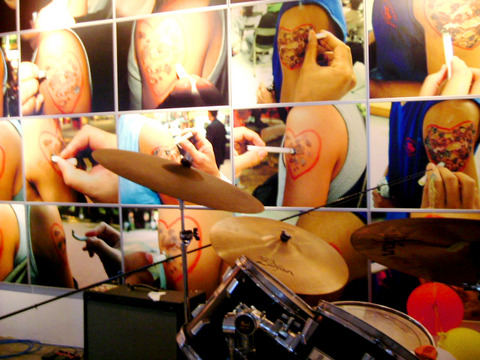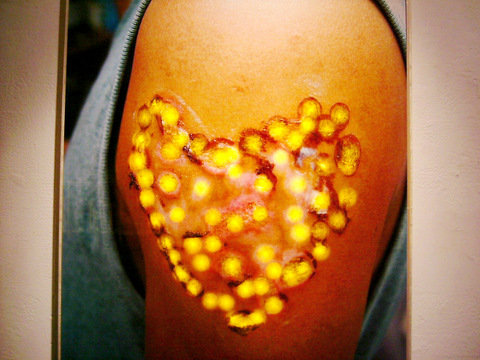If you're city-bound this summer, there are several refreshing art exhibitions to excite, soothe or even shock you. The works on view range from the lighthearted to the digitally interactive to outrageous performance art. In the exhibitions we see several art stereotypes: the professorial artist didactically telling his viewers about color theory; women as nurturers trying to give back to their communities; and the rock ‘n’ roll burnout artist.
Singing in Your Brain is Tsao Hsun-chih's (曹訓誌) first solo exhibition. He has four projects on display and takes a playful approach to dense color theory and ideas regarding perception.
The first work is a video of a woman singing the well-known Happy Birthday song, except there is no sound coming from her mouth. On seeing her mouth move, the viewer mentally fills in the melody. Tsao says suggestion is quite overpowering to the senses and that even though we use these faculties, we often do not pay much attention to them. Focusing on how our minds can fill in melodies or perceive color and sensations is a lot like “singing in one's brain.” In another room, Tsao uses two wall-sized projections to illustrate that point. In one, an optical illusion occurs as multicolored pixels seem to fill the screen, but the video was made with only two colors, red and green, and the mind is tricked into perceiving purple, yellow, orange, white, and gray.

PHOTOS: SUSAN KENDZULAK
Over at the Taipei Cultural Center is a small exhibition organized by Taipei Artist Village director, Su Yao-hua (蘇瑤華). Titled Women in Taipei it brings together three female artists who try to include community, family and place in their art. Hsu Chia-jung (許嘉容), the only featured artist to live in Taipei, uses her personal family photos to construct three-dimensional mannequins. Using transparent positive film, she stitches the snaps together and uses a light bulb placed inside the mannequin to create a glowing image.
Thai artist Teerawat Mulvilai exhibits the private journals of Southeast Asian women who have made Taiwan their home, while American Lexa Walsh exhibits her Immortalization Project in which she collects nostalgic objects from people and then conducts interviews to examine sentimental attachment. This modus operandi has become a trend at the Taipei Artist Village where visiting artists from around the world exchange personal mementoes with members of the local community.
In addition to the exhibition at the Cultural Center, the Taipei Artist Village runs a schedule of art, dance and performance programs that change monthly according to which artists are in residency at any given time. The artist village has a pleasant cafe with fresh baked goods so one can take a peaceful rest between gallery rounds.

At IT Park, performance artist Cheng Shih-chun (鄭詩雋) has become a transgressive rock star. Photos of a previous event show passers-by stamping out cigarettes into a heart shape drawn on his upper arm as if to say love hurts. To further make his point, photo lightboxes glow brightly where the embers burned his skin. A drum kit, guitars and amps are strewn throughout the gallery. This is no commercial exhibition, as sex toys, cash, and butts are the detritus of the painful and difficult passage of adolescence into adulthood.
Exhibition notes:
What: Singing in My Brain by Tsao Hsun-chih (曹訓誌)
Where: Sly Art Gallery, Lane 11, 15-2 Zhongshan Rd N Sec 2, (台北市中山北路二段11巷15-2號1樓)
When: Until Aug. 27What: Women in Taipei
Where: Taipei Cultural Center, Exhibition Room 3, (台北市立社教館第三展覽室2F), 2F, 25 Bade Rd Sec 3, Taipei (台北市八德路3段25號)
When: Until Aug. 31What: Cheng Shih-chun (鄭詩雋)
Where: IT Park, 2/3 F, 41 Yitong St, Taipei (台北市伊通街41號2-3摟) Tel:2507-7243
When: Tuesday to Saturday from 1:00pm to 10:00 pm; until Sept. 2

On April 26, The Lancet published a letter from two doctors at Taichung-based China Medical University Hospital (CMUH) warning that “Taiwan’s Health Care System is on the Brink of Collapse.” The authors said that “Years of policy inaction and mismanagement of resources have led to the National Health Insurance system operating under unsustainable conditions.” The pushback was immediate. Errors in the paper were quickly identified and publicized, to discredit the authors (the hospital apologized). CNA reported that CMUH said the letter described Taiwan in 2021 as having 62 nurses per 10,000 people, when the correct number was 78 nurses per 10,000

As we live longer, our risk of cognitive impairment is increasing. How can we delay the onset of symptoms? Do we have to give up every indulgence or can small changes make a difference? We asked neurologists for tips on how to keep our brains healthy for life. TAKE CARE OF YOUR HEALTH “All of the sensible things that apply to bodily health apply to brain health,” says Suzanne O’Sullivan, a consultant in neurology at the National Hospital for Neurology and Neurosurgery in London, and the author of The Age of Diagnosis. “When you’re 20, you can get away with absolute

May 5 to May 11 What started out as friction between Taiwanese students at Taichung First High School and a Japanese head cook escalated dramatically over the first two weeks of May 1927. It began on April 30 when the cook’s wife knew that lotus starch used in that night’s dinner had rat feces in it, but failed to inform staff until the meal was already prepared. The students believed that her silence was intentional, and filed a complaint. The school’s Japanese administrators sided with the cook’s family, dismissing the students as troublemakers and clamping down on their freedoms — with

As Donald Trump’s executive order in March led to the shuttering of Voice of America (VOA) — the global broadcaster whose roots date back to the fight against Nazi propaganda — he quickly attracted support from figures not used to aligning themselves with any US administration. Trump had ordered the US Agency for Global Media, the federal agency that funds VOA and other groups promoting independent journalism overseas, to be “eliminated to the maximum extent consistent with applicable law.” The decision suddenly halted programming in 49 languages to more than 425 million people. In Moscow, Margarita Simonyan, the hardline editor-in-chief of the